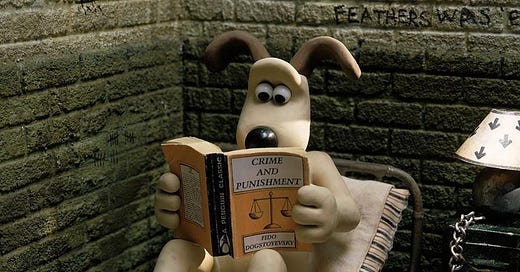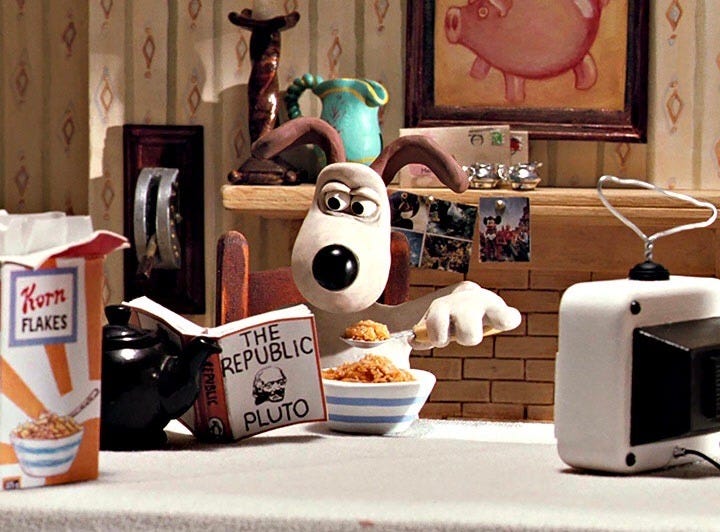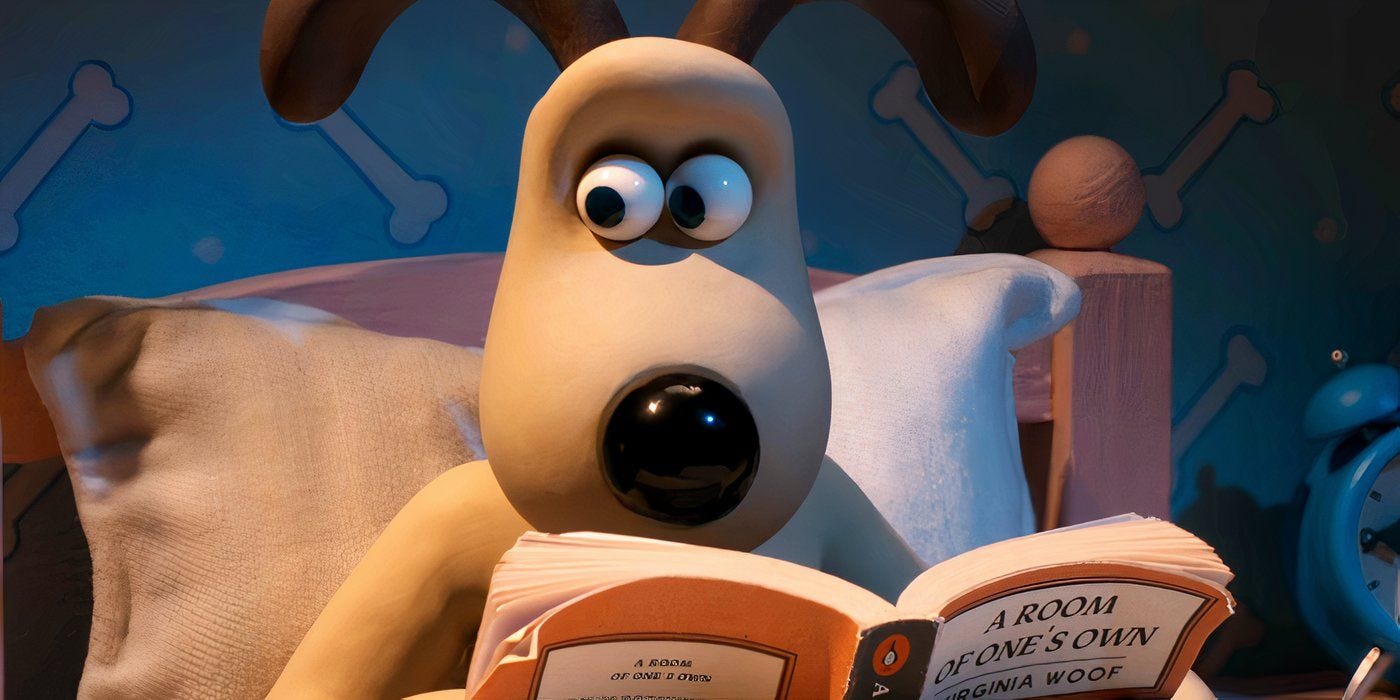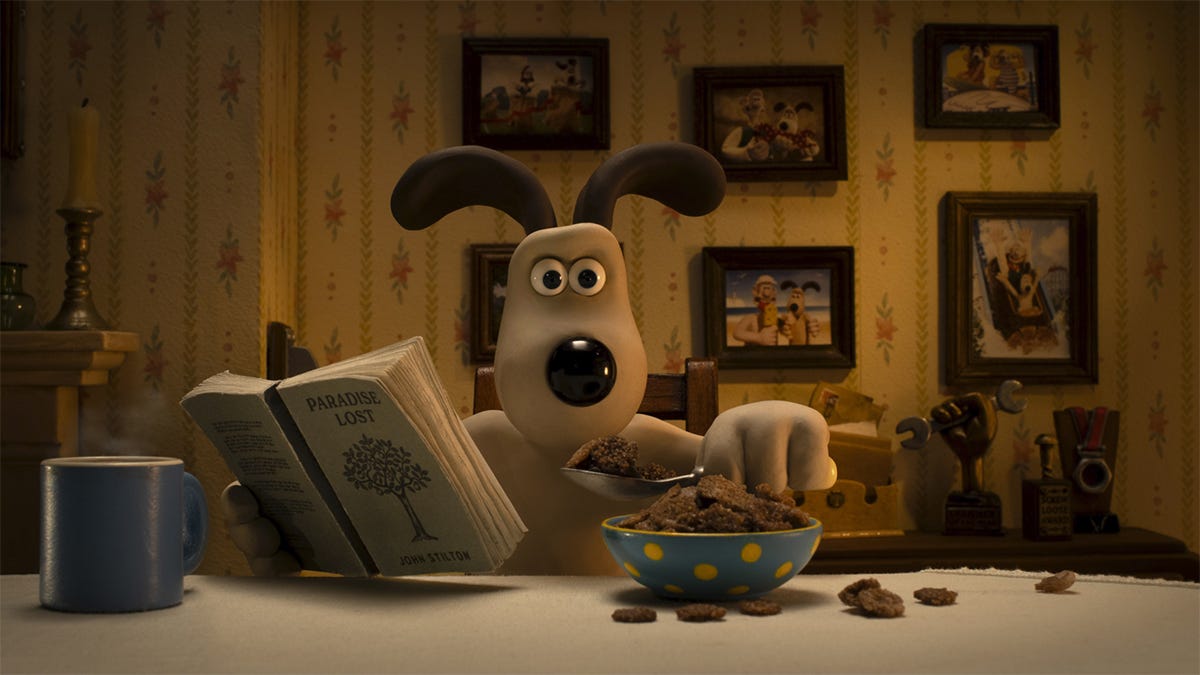The Significance of Gromit's Reading Habits
Following the release of Vengeance Most Fowl, the beagle's reading list has been celebrated amongst Wallace & Gromit fans and avid readers alike—but what can we learn from Gromit's book selection?
Known for his pensive character, the beloved beagle, Gromit, has captured audiences with his quiet demeanor since Aardman’s release, A Grand Day Out in 1989. Since Gromit’s debut, he has cemented himself as the intellectual’s spirit-animal, with his taste for Bach, love of knitting, and passion for the literary arts each explored in the claymation franchise. Beyond alluding to Gromit’s sophistication, however, are his reading habits suggesting a broader theme of mind vs. machine, not only present in his respective film’s narratives, but also reflective of his relationship with the inventor Wallace. That is, while Wallace’s creations wreck havoc, endanger lives, and lead to crime, etc., Gromit’s background in the arts and culture consistently leads to Wallace’s—and English society at large’s, rescue.
With the prevalence of A.I., now, more than ever, Gromit’s narrative function as “hero” speaks to the importance of being well read in a world dominated by technological advancement. And while Gromit’s reading habits continuously make an effective argument for reading the classics, his book selection, furthermore, speaks to the themes which dominate life under Wallace’s dictatorship. By understanding what Gromit reads, one can thus begin to understand the inner-turmoil plaguing the beagle as he navigates his life under a crazed inventor’s household.
Plato’s The Republic - The Wrong Trousers (1993)
Unsurprisingly, the first literary work to make an appearance in the Wallace & Gromit films is The Republic. While Plato’s arguments for justice speak to the criminal Feathers McGraw’s appearance in The Wrong Trousers, in the broader sense, Plato’s allegory of the cave reflects both Wallace and Gromit’s perpetual struggle to understand each other’s inner-world.
While Wallace is a brilliant inventor who seeks to educate the public on the potentials of technological advancement, he remains ignorant to the human public he attempts to serve. Contrary to this, Gromit is cultured, however struggles to understand Wallace’s perceived need for a life aided by technology. Although both characters are enlightened on opposite ends of the spectrum, The Wrong Trousers makes it clear that an analog lifestyle can flourish without technological advancement, while, contrary to this, proponents of a digital lifestyle remain wholly ignorant without cultural and historical awareness.
Plato’s The Republic being the first book audiences observe Gromit reading therefore sets the framework for the narrative world Wallace and Gromit have built. Notably, Plato’s argument for an “ideal city” is reflective of the ideal lifestyle Wallace and Gromit are both continuously seeking to cultivate within their respective journeys to enlightenment. While Gromit is devoted to a philosophical education, Wallace is loyal to math and science—so, while balance may rarely be found within the household, the “justice” (or success) found from the Wallace & Gromit films can be attributed to the characters’ juxtaposition.
It should be noted, however, that under Plato’s proposed caste system, he argues that the “philosophers” should reign supreme—meaning that, contrary to what Wallace believes, it is the well-educated Gromit who truly wears the pants in the relationship—hence, a double meaning to Wallace’s “the wrong trousers”.
Crime and Punishment - A Close Shave (1995)
Following the events of The Wrong Trousers, Gromit, once more, finds himself suffering the brunt of Wallace’s inventions in A Close Shave, as he is wrongfully imprisoned for sheep rustling—an inadvertent effect of Wallace’s creation of an updated knitting machine. As Gromit passes his time in prison, he is observed to be reading a copy of Dostoyevsky’s Crime and Punishment—a fitting title for his new environment.
While Dostoyevsky’s magnum opus explores the emotional implications of a crime as great as homicide, Gromit, rather, is internalizing the effects of being framed for theft. —Yet, if the beagle is innocent, how might reading Crime and Punishment aid Gromit in his introspection?
Well, rather than his book selection speaking to the film’s obvious theme of the justice system, Dostoyevsky’s prose more so relates to Gromit’s feelings of isolation, loneliness, and dependency under a household run by Wallace. As for the parallels in Raskolnikov’s narrative, we see his flaws and resentment reflected in the villain of A Close Shave, Preston, the robotic dog originally intended to look after Wallace’s love interest, Wendolene.
Seeing that the plot of Crime and Punishment relates more so with the antagonist of A Close Shave than it does with Gromit, one can thus infer that much of Gromit’s motivation for reading classic literature, is to better understand the psyche of others. In short, Gromit is an empath.
A Room of One’s Own - Vengeance Most Fowl (2024)
Aardman’s most recent installment to the Wallace & Gromit franchise, Vengeance Most Fowl, serves as a sequel to the events of The Wrong Trousers, having taken place 20 years prior.
As one might recall in The Wrong Trousers, Gromit had been kicked out of his bedroom, so that the villainous Feathers Mcgraw might make himself more comfortable under Wallace’s accommodations (and enablement). Similarly, 20 years later, Wallace infringes upon Gromit’s living arrangement, by placing his invention the “Norbot,” in Gromit’s bedroom, thus resulting in a disruptive environment to his rest and reading habits. Given that Gromit, and by extension, his needed solitude, has been repeatedly treated as an afterthought by Wallace, it should come as no surprise that Gromit relates to the struggles of the 20th century oppressed women reflected in Virginia Woolf’s essay.
In the literal sense, Gromit’s reading of Virginia Woolf’s A Room of One’s Own, points to the importance of Gromit retaining a proper space to exist outside of Wallace’s dominance, but furthermore, also suggests that Gromit seeks independence, agency, and equality within his relationship with Wallace—whilst also suggesting that Gromic is a canonical feminist. Beyond Gromit’s identity as an ally, however, it could be fairly argued that given his history with Wallace, Gromit, as well, is a victim of a patriarchal institution.
Paradise Lost - Vengeance Most Fowl (2024)
John Milton’s epic, Paradise Lost, retells the biblical Fall of Man, thus exploring Good vs. Evil and the dual nature of knowledge. Just as Milton’s Adam and Eve come to realize the dangers of ultimate knowledge, a similar theme is reflected in the plot of Vengeance Most Fowl, where Wallace’s creation of an A.I. gardening gnome leads to destruction, as well as the joys of gardening ruined.
While Vengeance Most Fowl begins with Gromit tending to an idyllic garden reminiscent of Eden, Wallace soon introduces the temptations of an automated gardening system—thus, reflective of Eve and the apple. Under the robot Norbot’s care, the garden soon transforms into a sterile and eventually, dangerous, environment—that is, to further allude to knowledge and destruction’s symbiotic relationship.
Of course, the nefarious nature of the Norbots is ultimately a result of the villainous Feathers McGraw, (another allusion to the battle of Good and Evil)—meaning, while Wallace and Gromit assume the roles of the first Man and Woman, Feathers, rather, is meant to act as Satan, an evil entity willing to manipulate Man’s greed and curiosity.
Lauded by critics, Vengeance Most Fowl is a cautionary tale warning against the temptations of a seemingly all-knowing Artificial Intelligence—but less so observed by critics, is the brilliant parallel between Wallace & Gromit and Milton’s rendition of the Fall of Man.






